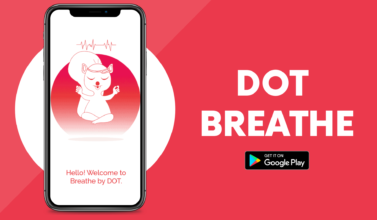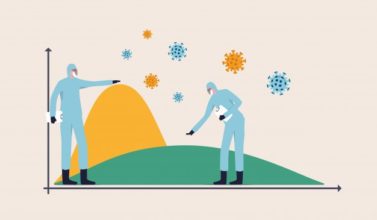As Coronavirus spreads across the globe, we want to spread awareness and urge everyone to take preventative measures.
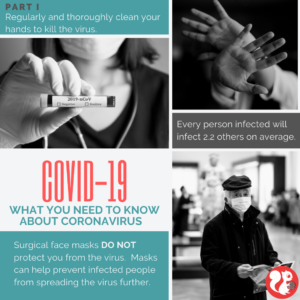
PART ONE
Regularly and thoroughly clean your hands with soap and water to kill the virus. Especially after going to the bathroom; before eating; and after blowing your nose, coughing, or sneezing.
To estimate how easily a virus spreads, scientists calculate its “basic reproduction number,” or R0. The virus that causes the disease COVID-19, is estimated at about 2.2, meaning a single infected person will infect about 2.2 others, on average. By comparison, the flu has an R0 of 1.3.
Standard surgical masks cannot protect you from SARS-CoV-2, as they are not designed to block out viral particles and do not lay flush to the face.That being said, surgical masks can help prevent infected people from spreading the virus further by blocking any respiratory droplets that could be expelled from their mouths.
PART TWO
Those with COVID-19 may have little to no symptoms. You may not know you have symptoms of COVID-19 because they are similar to a cold or flu. These may include include fever, cough and difficulty breathing, and rarer symptoms include dizziness, nausea, vomiting and a runny nose. In severe cases, the disease can progress into a serious pneumonia-like illness.
Viruses that affect the respiratory system enter the body through mucosal membranes which are found in the nose, oral cavity and lips. Touching our face is the easiest way to acquire a viral infection.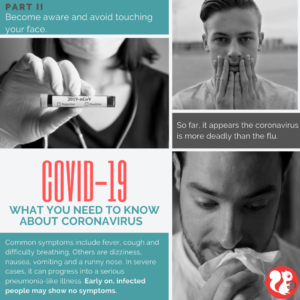
It is indeed very difficult to break the habit of touching our faces since it’s subconscious behaviour. Therefore the first step is to realize how often we touch our faces. Keeping a visual stimulus like a tissue box can be a helpful reminder.
So far, the coronavirus appears to be more deadly than the flu. The annual flu typically has a mortality rate of around 0.1% in the U.S. In comparison, recent data suggests that COVID-19 has a mortality rate more than 20 times higher, of around 2.3%.
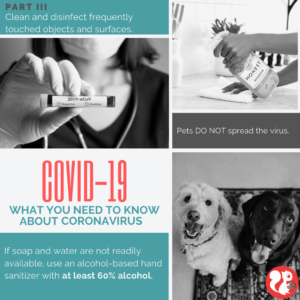
PART THREE
Wash your hands often with soap and water for at least 20 seconds, especially after going to the bathroom; before eating; and after blowing your nose, coughing, or sneezing. If soap and water are not readily available, use an alcohol-based hand sanitizer with at least 60% alcohol.
Regularly clean and disinfect surfaces that people touch frequently such as toilets, bedside tables, doorknobs, phones and television remotes with regular household cleaners or diluted bleach (1 part bleach to 9 parts water).
-No evidence suggests that pets could infect humans. In 2003, Several dogs and cats tested positive for a similar virus (SARS-CoV) however there was no evidence of viral transmission from pet dogs or cats to humans.
PART FOUR
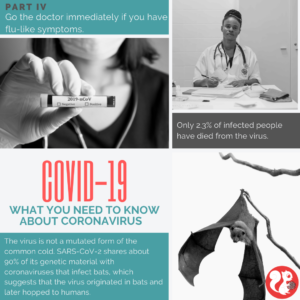
If you are sick with COVID-19 or suspect you are infected with the virus, isolate yourself, with little or no contact with others. Call ahead before visiting a doctor and inform them of your condition. They will provide you with the necessary steps to move forward. Wear a face mask when speaking to other people. Monitor your condition closely and seek immediate medical attention if you have difficulty breathing.
If you have COVID-19, there is no need to panic. About 81% of people who are infected with the coronavirus have mild cases of COVID-19. About 13.8% report severe illness, meaning they have shortness of breath, or require supplemental oxygen, and about 4.7% are critical, meaning they face respiratory failure, multi-organ failure or septic shock. The data thus far suggests that only around 2.3% of people infected with COVID-19 die from the virus.
Coronavirus is a large family of viruses that includes many different diseases. COVID-19 does share similarities with other coronaviruses, four of which can cause the common cold. All five viruses have spiky projections on their surfaces and utilize so-called spike proteins to infect host cells. This particular virus shares about 90% of its genetic material with coronaviruses that infect bats, which suggests that the virus originated in bats and later hopped to humans. Evidence suggests that the virus passed through an intermediate animal before infecting humans.
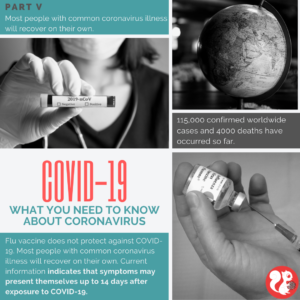
PART FIVE
Flu vaccine DOES NOT protect against COVID-19. For now, there is no specific treatments for most people with COVID-19. At this time, there is no vaccine for COVID-19. Your health care provider may recommend steps you can take to relieve symptoms.
Current information indicates that symptoms may present themselves up to 14 days after exposure to COVID-19. People with common coronavirus illness will recover on their own.
Globally around 115,000 cases have been confirmed and there have been 4000 deaths so far. The large majority of cases and deaths have been in mainland China, but that trend is changing. There have been 832 deaths and 32,495 cases linked to the virus in other countries, mostly in Italy, Iran, South Korea, Spain, France and Germany.
PART SIX
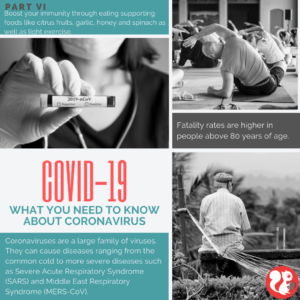
Coronaviruses are a large family of viruses. They can cause diseases ranging from the common cold to more severe diseases such as Severe Acute Respiratory Syndrome (SARS) and Middle East Respiratory Syndrome (MERS-CoV). COVID-19 is a new disease that has not been previously identified in humans. China determined that the virus is responsible for the outbreak of pneumonia in Wuhan. Authorities in China and worldwide are conducting further investigations to better understand where the disease came from.
Fatality rate was 14.8% in people 80 or older, likely reflecting the presence of other diseases, a weaker immune system, or simply worse overall health. By contrast, the fatality rate was 1.3% in 50-somethings, 0.4% in 40-somethings, and 0.2% in people 10 to 39.
While there is no cure we can most certainly boost our immunity to better equip ourselves so our bodies can fight back. Reducing stress, getting proper sleep, consuming immunity boosting vitamins and foods and exercising are essential measures. Be careful when exercising so as to not induce further stress on the body.

